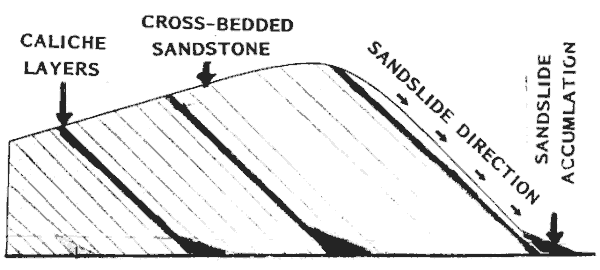 |
Science Frontiers ONLINE No. 132: NOV-DEC 2000 |
|
|
Sandslides: Desert Catastrophes
But what kind of catastrophes occur on desolate, riverless deserts? Wind is always blowing sand about and dunes creep along in deserts, but healthy animals easily avoid burial. Of course, there are rare, sudden downpours even on the Gobi. But one would expect this rain to be quickly absorbed by the sand.
Intrigued by the evidence of unexpected catastrophism in the Gobi, scientists from the American Museum of Natural History first took a look at Nebraska's strange Sand Hills. These Sand Hills stretch for thousands of square miles, reach heights of 400 feet, and are believed to be of aeolian origin during the Pleistocene. (See ETM7 in Carolina Bays) Being a modern analog of the ancient Gobi, the Nebraska Sand Hills might provide some insights as to what happened long ago in the Gobi.
An important clue occurs during the summer, when heavy thunderstorms sometimes trigger avalanches of wet sand called "debris flows". These sandslides may be 900 feet long, 50 feet wide, and 4 feet deep. Although they have occasionally partly buried ranch buildings, they are too slow and small to endangerlivestock and wild animals. But what if they were much larger and faster?
Back on the Gobi, geologists remarked that the rich fossil deposits were found in structureless sandstone; i.e., there was none of the cross-bedding seen in sandstones elsewhere in the region. Furthermore, fossils were extremely rare in the cross-bedded sandstones, which were built up over long periods of time. It looked as if the structureless, fossiliferous sandstones were sandslides differing from those in Nebraska in their much greater magnitude. But why were the Gobi sandslides so much larger and, apparently, faster?
The next clue came from the recent devastating mudflows in California and Central America caused by heavy rains. These debris flows were made deadly when the infiltrating rainwater was blocked by bedrock. The accumulating water turned the soil into a muddy slurries that raced down hills at high velocities, overtaking animals (including many people) trying to escape.
There is no bedrock in the Gobi, but a little digging encountered impervious layers of caliche. The Gobi caliche consists of layers of sandgrains cemented together by calcium carbonate. Typically located 2-3 feet below the dune surfaces, the caliche layers were evidence that the Gobi had experienced benign periods in the past with low winds, stable dunes and more moisture. But when heavy rains doused the Gobi dunes, the water was blocked by these caliche layers. Result: fluidized sand and catastrophic sand slides. These Cretaceous events were deadly for wildlife but blessings for future paleontologists.
(Dingus, Lowell, and Loope, David; "Death in the Dunes," Natural History, 109:50, July-August 2000.)
Comment. The anomalous fossils have been explained by a little digging and good reasoning.
 Gobi sandslides occurred when impervious caliche layers helped fluidize the sand. Only the sandslide accumulations contain fossils of high fidelity. |
Other Sites of Interest
|